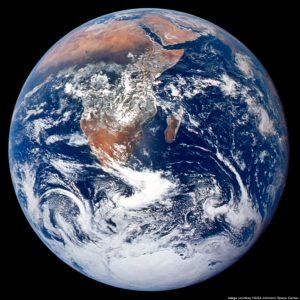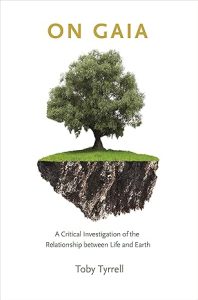In my previous article “Liking Lichens” I discussed the scientific concept of symbiosis where two or more lifeform species live together in a cooperative arrangement. In the “Gaia hypothesis” the earth and all its lifeforms are proposed to have evolved in a somewhat similar manner. This hypothesis proposes that living organisms have evolved to interact with their inorganic surroundings on earth to form a synergistic and self-regulating complex system that maintains and perpetuates life on the planet. It is an incredible hypothesis if you think about it, and on the surface, it is clearly an approach to explain the origin and maintenance of life on earth without any need for a Creator. It is an idea based on naturalism and pantheism.
The mythical Gaia was the Greek goddess personifying the earth. Another way to understand the ancient concept is to say that Gaia was the Greek version of “Mother Nature.” When chemist James Lovelock (1919-2022) and microbiologist Lynn Margulis (1938-2011) initially composed the Gaia hypothesis in the early 1970s, it was criticized by many as being too teleological for secular scientific acceptance and especially the concept of natural selection. But after several books and modifications over the 70s and 80s, mainly by Lovelock, it had gained some acceptance, especially for some in climate activist circles.
Figure 1. An Image of Gaia Lifeforms at Work According to the Gaia Hypothesis.
The Gaia hypothesis has incorporated ideas about the evolution of organisms and their effect on the stability of life on the earth. Life is supposed to be able to stabilize global temperature, salinity of seawater, atmospheric oxygen levels and other environmental variables. The hypothesis posits that organisms co-evolve with their environment, and that the environment in turn influences the lifeforms by some sort of natural selection process. It is an evolutionary belief system that says the earth has life so the earth itself must have worked in some way to create and modify it.
Figure 2. NASA’s 2012 Outer Space Image of the Earth, or Gaia According to Some.
A serious difficulty of Gaia I see is that it does not explain why the earth is the only planet that has evolved to have this amazing synergy of life and inorganic matter. If any planet could have the power to create itself into a living synergistic organism, I would expect that there would be abundant life on Mars today as well as on Earth.
In 2013 earth system scientist Toby Tyrell wrote the Princeton University Press published book, On Gaia: A Critical Investigation of the Relationship between Life and Earth. According to Wikipedia, “The author systematically evaluated the key components of the Gaia hypothesis, questioning its claims that Earth has remained a favorable habitat for life due to life’s role in shaping the environment. He argues that the feedback mechanisms described by Gaia do not provide sufficient protection against environmental stability and that Earth’s continued habitability has been partly a result of chance rather than solely because it is a self-regulating system.”
This evaluation makes some sense, but the foundational presupposition of natural selection can still be seen in Tyrell’s reliance on chance. He, along with most other secular scientists, may not like the Gaia hypothesis but they, as atheists, still must have some sort of a Darwinian natural selection process to explain life, so they remain as devoted followers of Mother Nature. As I have written numerous times natural selection has been scientifically proven to be dead. Nature is stupid and cannot select anything. The truth is that more and more evidence is indicating that lifeforms are pre-programmed by their Creator to adapt to various environments. This is an internal, not external process. As a result, when an organism experiences a new environment it either adapts as it is able, it dies, or it goes extinct.
Nevertheless, evolutionists still attempt to apply selective abilities to nature. A task that foundationally consists of replacing God with a volitional, creative agent (nature) that can in their minds be the author of all of the intricate complexity of life.
Figure 3. Tyrell’s Interesting Book Cover.
DEEP TIME:
Darwinian evolutionists today mostly ignore Gaia and its proponents due to the teleological (design) aspects that are inherent in it. But both the Darwinians and the Gaia proponents hold to the same timeline. Darwinists believe in a 3.5-billion-years period of macroevolution when simple life slowly became complex. In Gaia the same 3.5-billion-years are used to explain the synergistic transformation of lifeforms and Earth into the Gaia imagined today. In this way Gaia is tied to conventional secular history. This timeline is a sharp contrast to the six-day creation, the Fall, the global Flood, and the introduction of Christ of the biblical and recent history that takes less than a total of 7,000 years. The deep time of the materialists, the naturalists, and Gaia is in each case presupposed and is not historically or scientifically proven.
GAIA 2.0:
In 2018 Timothy Lenton and Bruno Latour published a paper with the title “Gaia 2.0: Could humans add some level of self-awareness to Earth’s self-regulation?” [Science 14 Sep 2018 vol. 361, Issue 6407, p. 1066-1068.] The first paragraph of this paper reads as follows: “According to Lovelock and Margullis’s Gaia hypothesis, living things are part of a planetary-scale self-regulating system that has maintained habitable conditions for the past 3.5 billion years. Gaia has operated without foresight or planning on the part of organisms, but the evolution of humans and their technology are changing that. Earth has now entered a new epoch termed the Anthropocene and humans are beginning to become aware of the global consequences of their actions. As a result, deliberate self-regulation—from personal action to global geoengineering schemes—is either happening or imminently possible. Making such conscious choices to operate within Gaia constitutes a fundamental new state of Gaia, which we term Gaia 2.0. By emphasizing the agency of life-forms and their ability to set goals, Gaia 2.0 may be an effective framework for fostering global sustainability.”
Climate change alarmists have always been fans of Gaia and in this paper, politics can be seen as a thread throughout. Gaia 2.0 looks to me to be more social philosophy than science. The authors even say that “Gaia 2.0 will have difficulty gaining much traction because large parts of the human population are indifferent to the Anthropocene, and many deny anthropogenic climate change.” I submit that there are good reasons for a mindset of climate catastrophe rejection by so many. Nevertheless, Gaia 2.0 has brought the concept of Gaia back to the forefront of climate activists’ attention. If you have read much of my writing over the years you would know that I am very dubious about the entire concept of the geologic timeline. Adding this current geological epoch (the Anthropocene) to what I believe is nothing but a mental abstraction does not add anything to science in my opinion.
Then in 2024 a paper with the title, “Gaia as Seen from Within” [Theory, Culture & Society 2024, Vol. 41(5) 69-90] was published that recounts the conversations over the years since 2018 (and the introduction of Gaia 2.0). Those involved in the conversations were Timothy Lenton (a scientist), Bruno Latour (a philosopher), and Sébastien Dutreuil (a philosopher). Lenton and Latour were the authors of the original paper on Gaia 2.0. The 2024 paper seeks to increase the acceptance of and the political importance of Gaia 2.0. After reading several thousand words of philosophical gobbledygook, I have to judge their success as not particularly good. One thing I acquired from the paper is their conclusion that Gaia must be “seen” from within and not from without. That means they reject the ubiquitous images of the Earth from outer space as being representative of the true Gaia. For an example of which image they reject see Figure 2 in this article.
In conclusion, the Gaia hypothesis and Gaia 2.0 are fairy tales dreamed up in an ongoing attempt by lost and evil people to reject God and his Word. Next are some examples of what the Bible says about the topics in this article.
What does the Bible say about those who reject the Creator God?
- The wrath of God is being revealed from heaven against all the godlessness and wickedness of people, who suppress the truth by their wickedness, since what may be known about God has made it plain to them. For since the creation of the world God’s invisible qualities—his eternal power and divine nature—have been clearly seen, being understood from what has been made, so that people are without excuse. For although they knew God, they neither glorified him as God nor gave thanks to him, but their thinking became futile, and their foolish hearts were darkened. Although they claimed to be wise, they became fools and exchanged the glory of the immortal God for images made to look like a mortal human being and birds and animals and reptiles. (Romans 1:18-25.)
What does the Bible reveal regarding how the Earth (actually the entire universe) was created and holds together?
- The Son is the image of the invisible God, the firstborn over all creation. For in him all things were created: things in heaven and on earth, visible and invisible, whether thrones or powers or rulers or authorities; all things have been created through him and for him. He is before all things, and in him all things hold together. (Colossians 1:15-17.)
- The Son is the radiance of God’s glory and the exact representation of his being, sustaining all things by his powerful word. (Hebrews 1:3.)
- The God who made the world and everything in it is the Lord of heaven and earth and does not live in temples built by human hands. And he is not served by human hands, as if he needed anything. Rather, he himself gives everyone life and breath and everything else. (Acts 17:24-25.)
- In the beginning God created the heavens and the earth. (Genesis 1:1.)
God could not have made the situation any clearer. Jesus Christ is the Creator and our sustainer. It is to him that we must give all the glory! Amen.
J.D. Mitchell





